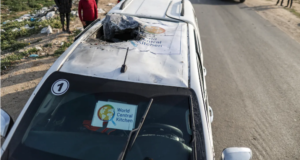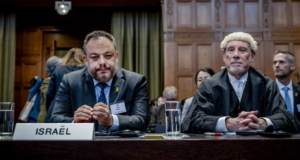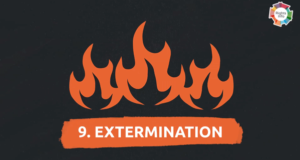A Calm Day in Gaza
by Ed Mast
We sit on the floor of a pleasantly-colored cinderblock apartment, one of a row of buildings painted in bright Santa Fe colors, in Rafah near the south end of the Gaza Strip. There are rugs on the floor and the ubiquitous pads that serve as beds by night and seats for guests by day. The woman of the house has invited us into her home and is serving us tea. This is daytime, there are no gunshots, and children play and follow us without fear.
These homes are a little squeezed together, with no space between or around, but otherwise one might imagine that the inhabitants have little to complain about. This is, however, the woman’s third home. She came here two months ago, when her other home was demolished, along with 96 others, because the Israeli settlement near Rafah wanted to expand. Everyone in these houses was driven out at the same time. They were awakened in the night, without warning, by bulldozers. This woman has been driven out of two other homes previously: in 1973, and in 1990, during the first Intifada. She does not at first mention the earlier home of her family, in Ashdod inside what is now Israel, from which her family was expelled in 1948.
On her wall is a clock with needlepoint stitching below it saying “God Bless Our Home.”
Outside we are cautioned not to walk too near the corner of the street. By night, gunfire from settlers and soldiers is common there, and it sometimes happens by day. We walk to an SOS orphanage, and see the pockmarks of rifle and tank shells in the walls.
We go to the southeast and southwest corners of Rafah. On the one corner is the border with the Israeli settlement which has been expanding and confiscating land. I take a few steps to look closer, and am again warned to step back. They point out a distant tower from which soldiers customarily shoot. Again, it’s daytime, and mostly the shooting happens at night.
On the other corner of Rafah, a high opaque metal wall is being built, to seal off the border with Egypt. The purpose of the wall is apparently to prevent the smuggling of weapons across the border, so Palestinians are to be walled in as well as out. “Rafah is a prison” one says to me. A swath of homes several miles long and maybe 100 yards wide must be demolished on the Gaza side of this wall, to leave a no-man’s-land border zone. We walk through what are labelled Block D and Block G and Block O, areas where these demolitions have taken place. They look like bombsites. This is a refugee camp, so the buildings are mostly made of concrete blocks, and easily pushed over. The sides of buildings look like sponges or coral reefs, so covered with bullet and missile holes. We pick our way through a landscape of rubble to see this. Several houses with whole sides shorn away, and one house tilted halfway to the ground, crumbling slowly before our eyes as if there had been an earthquake. A three-story house that is mostly still standing, battered with gaping holes and pockmarks, turns out to be the house where our friend Molly and the children of her host family were awakened in the night by Israeli gunfire penetrating the walls. (People ask us if we know “Maaaly?”) The family doesn’t live there anymore. No one lives in these crushed homes.
“This is our life” people tell us.
I climb up on one pile of rubble to look at the wall. People call to me: Get down! I hear tanktreads over near the wall behind some of the rubble. Even in the daytime they must stay out of the army’s sight.
We leave the area without incident to travel with our friends back to Gaza City, in the north of the Gaza Strip. Our friends came to Rafah that day to deliver a workshop on storytelling techniques for kindergarten teachers. We were able to come to Khan Younis and Rafah without any trouble in the morning, but in the afternoon the Khan Younis checkpoint is closed. 500 people are already waiting when we arrive at about 3:00. Linda and I walk up to the front and talk to the soldiers. We are able to negotiate the passing of one ambulance, but nothing else.
At about 8:30 that night the checkpoint opens and our friends, the early child education specialists, are able to drive us the 15 miles to their home in Gaza City. The night before, they got home at midnight. They are supposed to deliver workshops in Khan Younis and Rafah the rest of this week. This is the first income they’ve had in some months
 International Solidarity Movement Nonviolence. Justice. Freedom.
International Solidarity Movement Nonviolence. Justice. Freedom.


